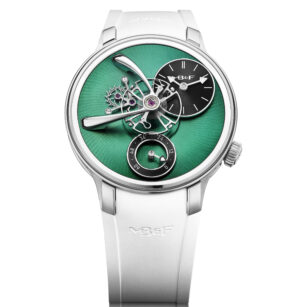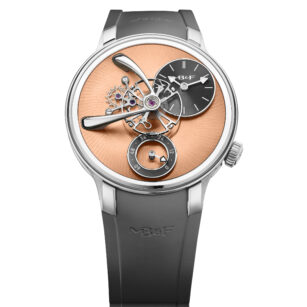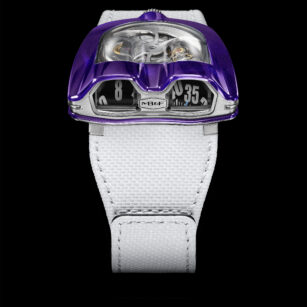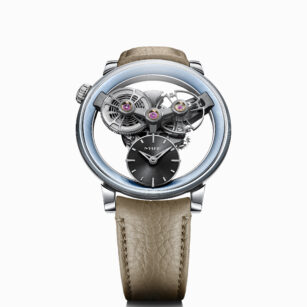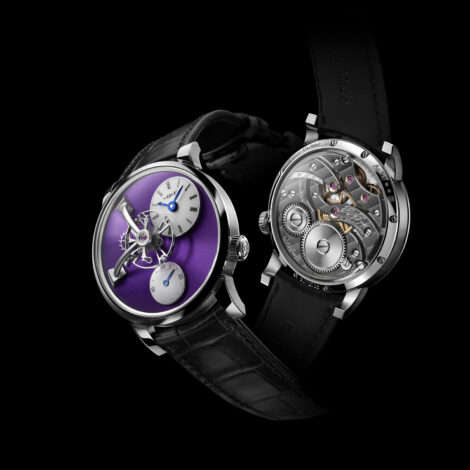
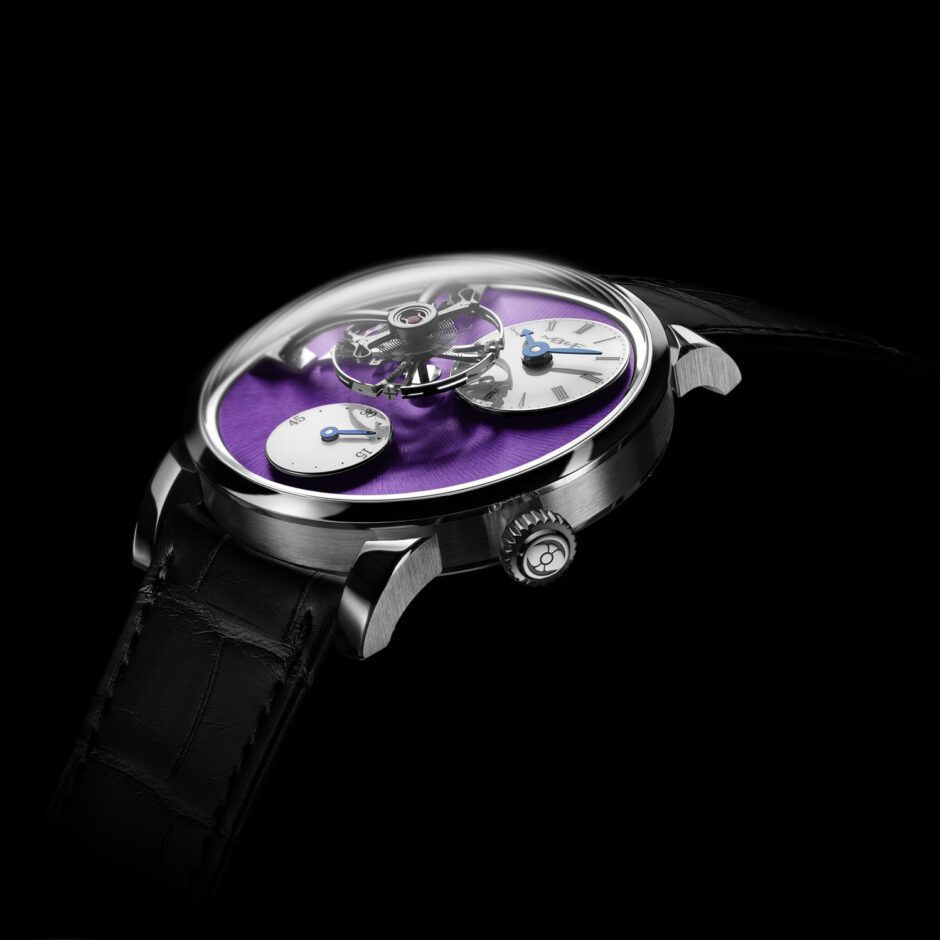
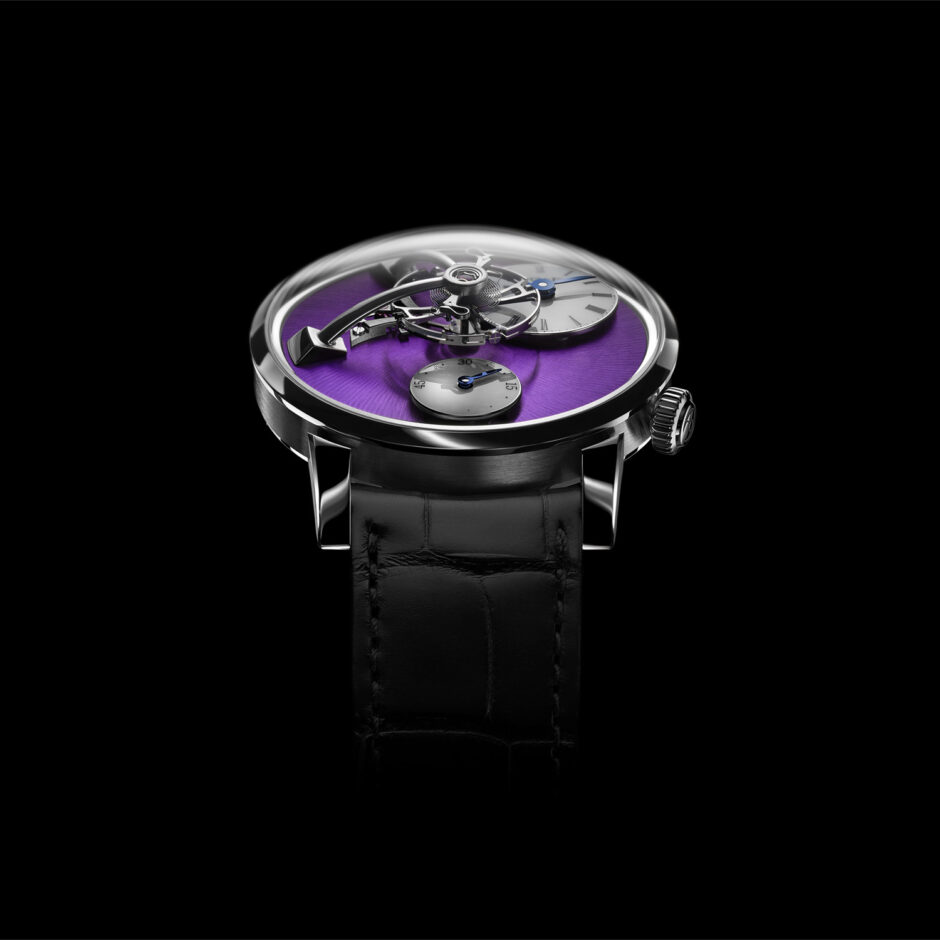
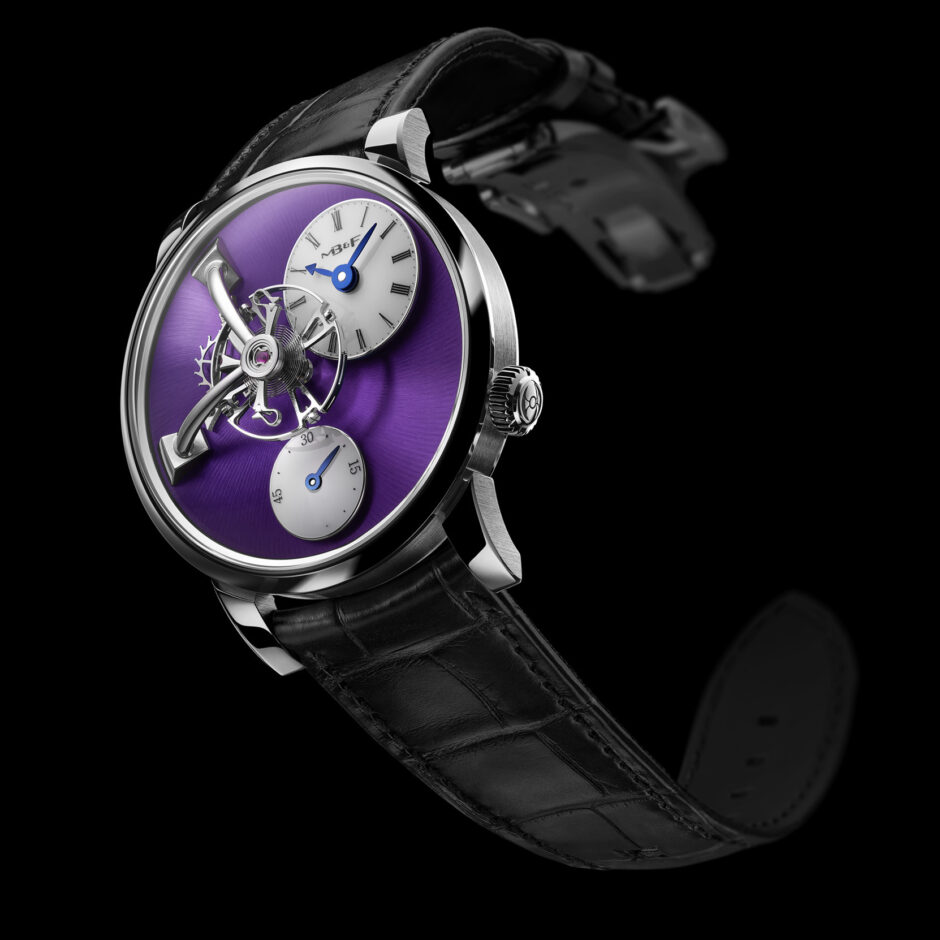
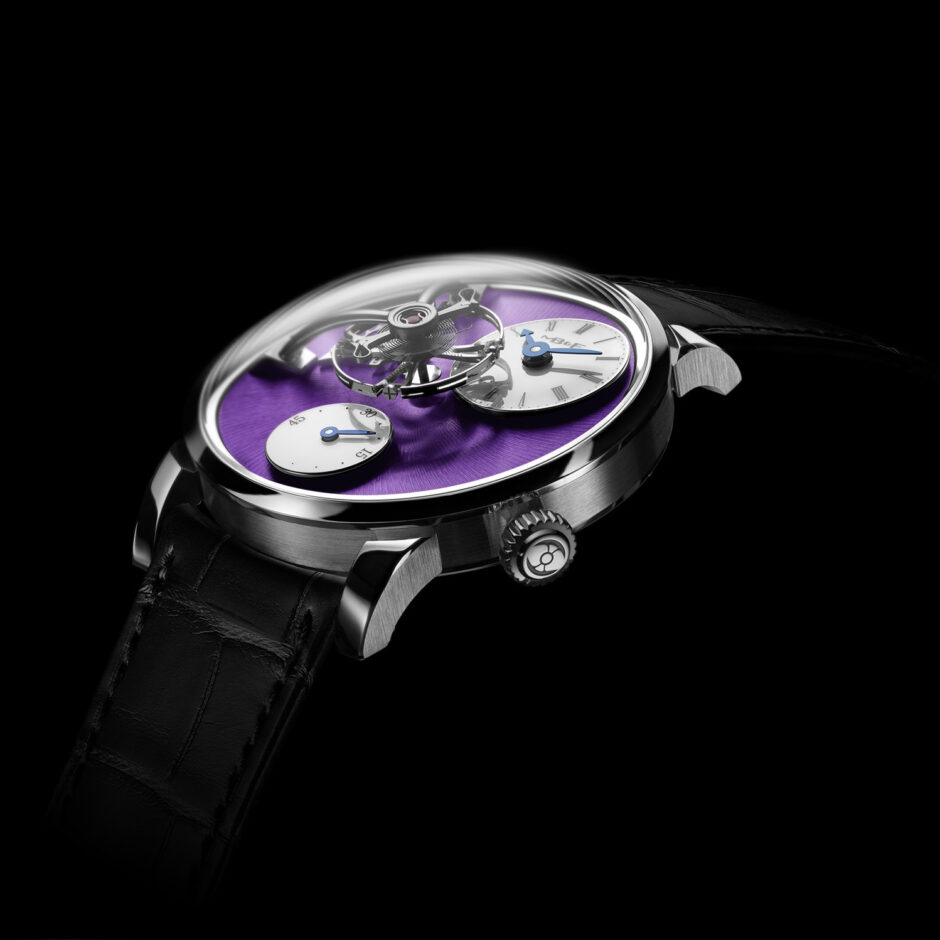

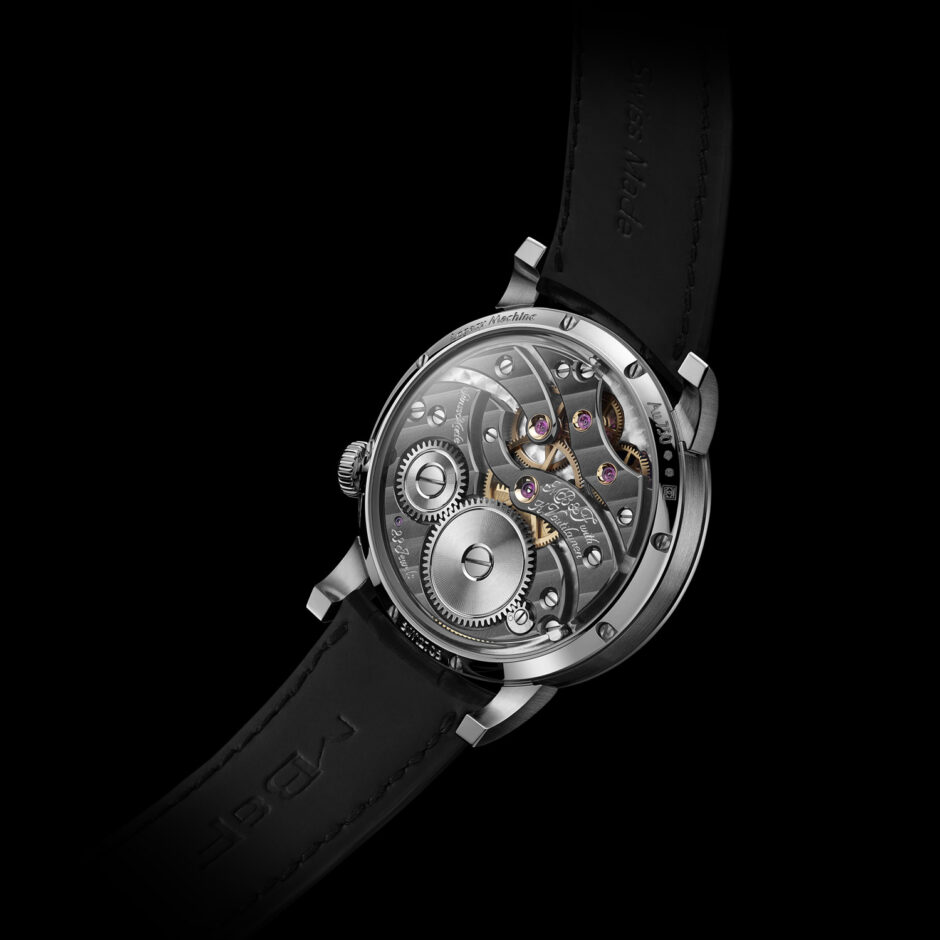

Legacy Machine 101 : The heritage of time, the quintessential clock.

LEGACY MACHINE 101
The Legacy Machine 101 (LM101) series was first launched in 2014. As its name “101” suggests, this piece focuses on the essential elements of a mechanical watch; enclosed within a 40mm-diameter case, it is one of the most compact Machines ever created by MB&F. At the time of its launch, the LM101 was also the very first movement developed entirely in-house by MB&F.
In 2021, the LM101 series evolves with new technically and aesthetically perfected versions, distinguished from previous editions by colored dials and including a steel version. Focusing even more on the essentials, the bezel and ‘Legacy Machine’ engraving disappear to make way entirely for the time and power reserve, shown on slightly larger sub-dials; but the real star is the flying balance typical of Legacy Machines, inheriting a double balance-spring in the process.
The Legacy Machine 101 quintessentially embodies and underscores what is essential in a mechanical watch: the balance wheel, which determines the precision of regulation, the energy reserve available until the next winding and, of course, the passage of time.
Visually, the LM101 is dominated by a large suspended balance wheel. Its slow oscillations draw the eye closer. The two pure-white dials float slightly above the movement’s finely sunrayed plate. At top right, superb blued hands contrast with the immaculate background to indicate hours and minutes in a highly legible manner. Below, a similar but smaller dial displays the 45-hour power reserve. Two ‘Frost’ limited editions add even more contrast between these elements and the glistening back of the hand-grained plate.
As if by magic, the sapphire crystal protecting the dial is almost invisible. You’d think you could reach out and touch the hypnotically powerful balance wheel, suspended from two finely sculpted arches in a solid block of metal. The mirror effect on the surface requires many hours of hand polishing.
On the reverse side of the Legacy Machine 101, the glass is domed to reduce the thickness of the case middle and, visually, the height of the watch. It reveals a remarkably hand-finished movement, with bridges and plates featuring sensual curves. The style, borrowed from the fine pocket watches of yesteryear, testifies to the importance attached to historical legitimacy.
While fidelity to the past is expressed through the refinement of undulating Côtes de Genève, polished angles, gold chatons and blued screws, the LM101’s movement is more than just that. It’s a movement that heralds a new era, the first to have been entirely designed and developed by MB&F. While the movement was developed entirely in-house, it was the renowned master watchmaker Kari Voutilainen who took responsibility for ensuring the historical accuracy of the bridges’ design and the movement’s refined finishes.
The LM101 was first launched in rose gold and 18-carat white gold, then in two ‘Frost’ limited editions with grained finish (18 and 33 pieces), followed by a 33-piece limited edition in 950 platinum and 18 pieces in palladium. The new 2021 versions are available in 18-carat white gold with a violet dial, in 18-carat 5N+ rose gold with a royal blue dial, and in steel with a light blue dial.
LEGACY MACHINE 101 IN DETAIL
Engine: The LM101’s movement resembles that of the Legacy Machine N°1, but that’s just an appearance. A closer look reveals a totally different caliber. It’s not just a scaled-down version of the LM1, but a movement specially developed in-house by MB&F, designed to fit perfectly into a 40 mm-diameter case.
At the heart of any mechanical watch movement are a balance wheel and a balance spring, whose oscillations must be isochronous (of constant duration) to ensure precision. MB&F’s creator, Maximilian Büsser, has a long-standing fascination with the slow-oscillating balances of the pocket watches of yesteryear – 2.5 Hz / 18,000 A/h instead of the 4 Hz / 28,800 A/h used today. So it’s no surprise that he started there.
The surprise comes from the radical way in which he has reinterpreted tradition. The balance is no longer, as usual, concealed on the back of the movement. It floats majestically high above the dials.
Placed like this, the oscillator can be considered avant-garde. Yet it remains traditional with its large size, 14 mm in diameter, its adjustment screws expressly developed for MB&F, its Breguet-curved balance-spring and its movable piton. The latest versions include a double balance-spring, first seen on the LM101 “Performance Art” editions born of the MB&F x H. Moser & Cie collaboration, in 2020.
If you thought the balance wheel on the Legacy Machine N°1 was big, it looks even bigger in the LM101’s reduced diameter.
Dials and indications : While the animated suspended balance dominates the LM101, the immaculate white dials for the time (hours and minutes) and power reserve are both aesthetically appealing and highly legible thanks to the strong contrast of the blue hands.
The three-dimensional effect produced by the pendulum floating in space is accentuated by the white dials, with their blued gold hands, which float just above the movement. These slightly domed, translucent dials are made using the stretched lacquer technique – several layers of lacquer are applied and heated so that they stretch over the surface of the dial.
To ensure the aesthetic purity of the dials, a sophisticated fastening underneath eliminates the need for visually intrusive screws. A fine golden circle surrounds each dial to reinforce the timeless classicism.
Refined finishes and historical legitimacy: While the movement was developed entirely in-house, renowned master watchmaker Kari Voutilainen took responsibility for ensuring the historical accuracy of the bridges’ design and the movement’s refined finishes.
A sunray pattern engraved on the surface of the plate (dial side) subtly draws the eye to different viewpoints, without distracting from the white time and power reserve dials and the floating suspended balance. But it is in the style and finishing of the bridges and plates visible on the back of the movement that Kari Voutilainen has particularly excelled. He has marvelously respected history through bridges with curved shapes and, as tradition dictates, widely spaced from each other and from the edge of the case.
On the back of the movement, oversized rubies housed in highly polished gold chatons form striking counterpoints to the côtes de Genève that run through the sensuously curved bridges. While they create a link with the stones found in fine antique pocket-watch movements, these bearings also have a functional role. They increase longevity by accommodating larger-diameter pinions and containing more oil.
In the late 18th and early 19th centuries, graining was created by treating components with an acid mixture and passing them over a flame (which could go wrong…). The result was a silvery-white, frosted surface protected from oxidation – an important treatment at a time when watches and clocks were by no means waterproof.
As watchmakers became more aware of the potential dangers of using strong acids, alternative methods were sought, the most satisfactory in terms of quality being to brush the surfaces very carefully with a wire brush. However, it is very difficult to achieve a uniform result, as excessive pressure or brushing for too long can quickly destroy the desired matt effect and produce irregularities.
Today, very few craftsmen have the talent and experience to create a traditional grained finish, and they jealously guard their secrets. The traditional graining used today is actually burnishing (compressing the metal without removing any material), resulting in a surface so hard that it is impossible to engrave by hand.
Inspiration and realization: The idea for the Legacy Machines was born when Maximilian Büsser asked himself: “What would have happened if I had been born in 1867 instead of 1967? With the appearance of the first wristwatches in the early 1900s, I would have wanted to create three-dimensional machines to wear on my wrist. Except that Goldorak, Star Wars and jet planes wouldn’t have been there to inspire me. I’d have had pocket watches, Jules Verne and the Eiffel Tower. So what would my early twentieth-century machines have looked like? They were bound to be round (in the traditional way) and three-dimensional (in the MB&F style). My answer: Legacy Machines.
Maximilian Büsser has a deep affinity with the pocket watches of the 18th and 19th centuries. Almost all of today’s complications were imagined during this period, and with only a pencil and a sheet of paper, without the aid of sophisticated software. The remarkably precise components – close to today’s standards – were manufactured on archaic machines, without electricity, before being finely decorated, assembled and adjusted with a quality we’d struggle to match today. The generous dimensions, compared to modern wristwatches, allowed for movements of pure architecture, with beautifully designed bridges and plates.
While all MB&F’s futuristic Horological Machines are based on the best of traditional watchmaking, Maximilian Büsser wanted to pay more homage to history by imagining the watch he would have created had he been born a hundred years earlier. With their large, slow-oscillating balance, domed dials, historically-designed bridges and refined classical finishes, Legacy Machines give the dream a highly contemporary reality imbued with traditional elegance.
LEGACY MACHINE 101
Motor Three-dimensional movement developed in-house by MB&F
Aesthetics and finish specifications: Kari Voutilainen
Manual winding, single barrel
Power reserve: 45 hours
Balance wheel: special 14 mm-diameter model with four traditional adjustment screws, floating above the movement and dials
Balance spring: traditional Breguet curve and mobile piton; Straumann® double balance spring for new 2021 editions.
Frequency: 18,000 A/h – 2.5 Hz
Number of components: 229 / 231 for 2021 editions
Number of rubies: 23
Chips: polished gold
Finishes: hand-crafted in 19th-century style, polished angles including hand-crafted re-entrants, côtes de Genève, hand-engraved; grained plate for the “Frost” editions; and black NAC bridges for the 2021 editions.
18K white gold case
Dimensions: 40 mm diameter, 16 mm thick
Number of components: 35
Sapphire crystals
Highly curved sapphire crystal on the dial and sapphire crystal on the caseback. Anti-reflective treatment on both sides
Purple
Hours, minutes and power reserve.
Large balance suspended above the dials
Strap and buckle
Hand-sewn alligator or calfskin with gold, platinum, steel or palladium buckle to match the case.

